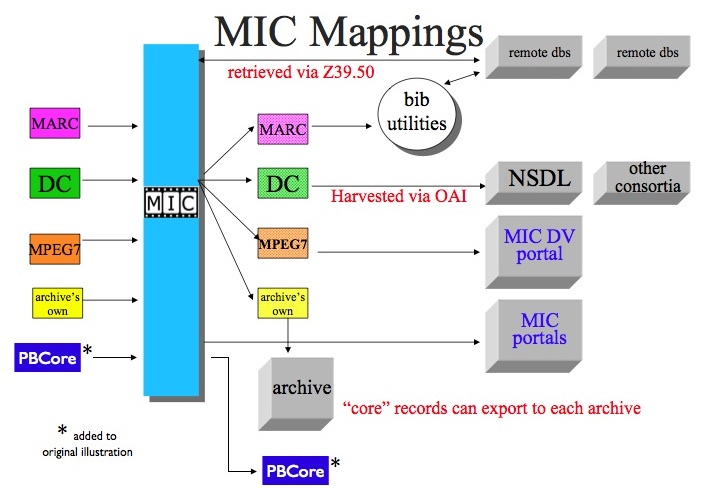| Applying
PBCore: Case Examples
of the Elements in Use |
MIC (Moving Image Collections)
& Metadata Dictionary Mappings
 Context Context
 PBCore Integration PBCore Integration
 Contacts Contacts
 Other Case Examples Other Case Examples
CONTEXT:
The Moving Image Collections (MIC) is a partnership of the Library of Congress and the Association of Moving Image Archivists. The MIC website (http://mic.loc.gov) integrates a union catalog, archive directory, and informational resources in a portal structure. Through these portals, customized information is delivered to diverse constituencies (archivists, researchers, educators, and the general public) on archival moving images, their preservation, and the images themselves.
As summarized by Jane D. Johnson, Project Manager for the Moving Image Collections...
MIC enables collaborative preservation decision-making and management on an international scale. Archivists can identify past preservation work and emerging critical needs, reducing duplication of effort, preventing loss through deterioration, and ensuring that titles are preserved from the best surviving footage. MIC seeks to raise awareness about preservation issues and risks to our film, television and video heritage by educating readers as to the care of home collections, the role of archives, and the preservation process. MIC's expert contributors have created and gathered hundreds of informational resources to illuminate these issues and fulfill the daily informational requirements of working archivists. Emerging from the National Moving Image Preservation Plans, MIC began as a preservation initiative. MIC's innovative architecture and community-driven development have allowed it to address the practical requirements of preserving analog artifacts as it evolves into an R&D platform to explore the leading edge of non-textual indexing, digital rights management, and educational use.
PBCORE INTEGRATION:
As summarized in a paper "MIC Metadata Strategies: Thinking Beyond Asset Management," by Jane D. Johnson (MIC Project Manager) (Journal of Digital Asset Management, Volume 2, Number 1, 1 January, 2006) the MIC project is working on a Mapping Utility...
With programming provided by Rutgers University Libraries, MIC has created a Mapping Utility enabling any moving image archive, regardless of metadata schema used, to share records globally through the MIC Union Catalog. The organization submits an application, sample records and field list, then MIC populates an online form with this data so that the organization can name MIC data element equivalents for its own fields. Still in the testing stages, the utility will allow small under-supported archives with very little metadata expertise to share their records with a much broader audience, while enabling large archives to integrate multiple metadata schema into a single system. This initiative exemplifies MIC's commitment to providing help with tools and standards to under-supported archives, while building consensus and shared solutions for broader constituencies.
MIC's goal is to ensure that these metadata schemas, and others to come, could be mapped into -- and out of -- its core registry for ingest into the MIC union catalog and subsequent export. The registry, a rigorously maintained and standardized application, consists of 48 fields. 12 Data elements from virtually any schema can be mapped, or translated, to and from these 48 fields. Currently MIC's extensible format-independent metadata design accommodates searching, export and display in MARC21, Dublin Core, MPEG-7, and several organizations' own formats. Maps to additional metadata schemas, such as MODS, PBCore and SMPTE DMS-1, are forthcoming.
The MIC core registry is detailed enough to retain the richness of extensive archival descriptions, but simple enough to provide users with readable, succinct displays of heterogeneous metadata from widely divergent sources. The MIC Core Registry supports the core user needs as defined by IFLA's Functional Requirements of Bibliographic Records (FRBR): to find entities that correspond to the user's stated search criteria, to lead through the list of MIC data elements, selecting from a pull-down menu the organization's own equivalents for the MIC data elements.
MIC's strategy to accommodate multiple schemas accomplishes two goals. First, it encourages participation because organizations aren't asked to conform to a particular schema imposed from above and unsuited to their needs. Secondly, the ability to map to multiple schemas allows archives to make their records available through a number of avenues, maximizing exposure to their collections. MARC allows interoperability, especially with print materials. Dublin Core enables OAI harvesting. MPEG-7 facilitates non-textual indexing. Each archive's own schema is important for local ownership. Using the MIC export utility, an archive employing Dublin Core for ease of use in-house can make its records available in MARC for Z39.50 access or in MPEG-7 for low-level indexing.
The following illustration shows how data are mapped from a variety of schema, through the MIC core registry, for export in different schema, which can then be distributed via numerous venues for different purposes. The PBCore metadata schema has been added to the original illustration.

CONTACTS:
Jane Johnson |
jjohnson |
@ |
loc.gov |
Grace Agnew |
gagnew |
@ |
rci.rutgers.edu |
|
|
MIC website |
|
|
|
MIC Cataloging & Metadata Portal |
|
|
|
Association of Moving Image Archivists |
|
|
|
|



